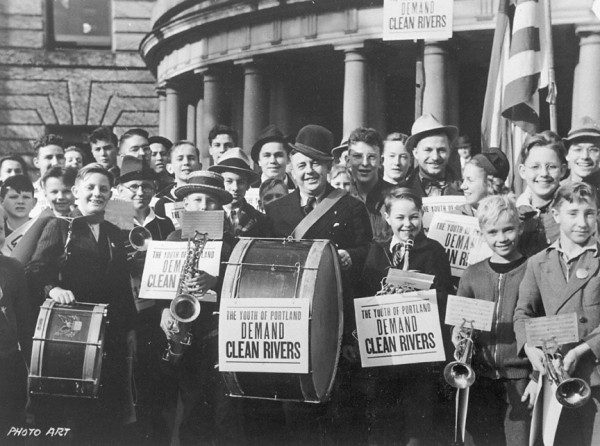Willamette History

Our Rivers Story
The Willamette River is formed by the confluence of the Middle and Coast Forks that originate in the mountains south and southeast of Eugene. The river flows almost 200 miles to the Columbia River in North Portland and drains more than 7 million acres of land.
Portland sits at the end of the drainage basin and is the most urbanized part of the watershed. Portland occupies only a small fraction of the river's watershed, but the 20 miles of Willamette River that pass through Portland are a critical gateway for many of the region’s fish and wildlife. Young salmon and steelhead live in the lower Willamette and its tributaries year-round, from between a few months to a couple of years depending on the species’ life cycle.
During the life cycle of salmon and steelhead, they migrate through Portland twice – once as juveniles on their way to the ocean and again as adults on their way back to spawn. The Willamette River is the only connection these fish have to their spawning grounds – places like Johnson or Crystal Springs creeks – where they can build nests, lay eggs, and mate.
Historically, the Willamette River ran "wild" during winter and spring, overflowing its many braided channels and sloughs and flooding extensive low-lying areas of the valley. The annual floodwaters—reflecting forty to fifty inches of seasonal precipitation—left fresh soil deposits in their wake and sustained an abundance of aquatic, plant, and animal life. David Douglas, the Scottish botanist who traveled through the Willamette Valley in the dry, hot months of late autumn 1826, witnessed spectacular changes to the valley landscape when he returned in November after the seasonal rains had begun. In place of the charred, Indian-fired countryside on his trip up the valley, he now reported lush, green prairie grasses, occasional marshlands, and small lakes.
Although numerous Native American bands lived along sections of the Willamette River system for some ten thousand years, their alterations to the river and its tributaries were minor, other than building weirs and traps to catch salmon and steelhead and using the waterway for transportation. Those relatively stable ecological relationships, however, began to change with the arrival of ever-increasing numbers of EuroAmericans during the 1840s and 1850s. The introduction of cattle, hogs, and sheep and then the expansion of wheat production contributed to dramatic changes to the valley landscape.
Portland developed as a "river city". As our urban areas expanded in population and in the amount of human activity, Portland treated its waterway as a place to dispose of both domestic and industrial wastes. In that sense, the river functioned as a commercial artery, serving the industrial and commercial needs of people who lived here. As the twentieth century advanced, transportation developers and agriculturalists built dikes and revetments (rock or cement embankments) designed to channelize the Willamette River and circumvent its meandering tendencies during high-water months. At the same time, the ever-increasing population and industries continued to treat the Willamette River as a dumping ground for domestic and industrial waste, essentially turning the main-stem river into an open sewer by the 1920s.
Slowly, private and public organizations and agencies began raising concern about the increasingly polluted Willamette River. In 1927, a Portland City Club report declared that the waterway was "filthy and ugly," with the City of Portland the worst offender. The river's growing notoriety finally prompted the Oregon Anti-Stream Pollution League to bring a modest pollution-abatement measure before the 1937 legislature. Although lawmakers easily passed the bill, Governor Charles Martin vetoed the measure. Undaunted, the Izaak Walton League and the Oregon Wildlife Federation countered the governor's veto and sponsored an initiative measure, the Water Purification and Prevention of Pollution bill, which voters easily approved in November 1938. The new law established the Oregon State Sanitary Authority, with modest enforcement powers, and marked the incremental beginnings of a program to rid the Willamette River system of pollution.




